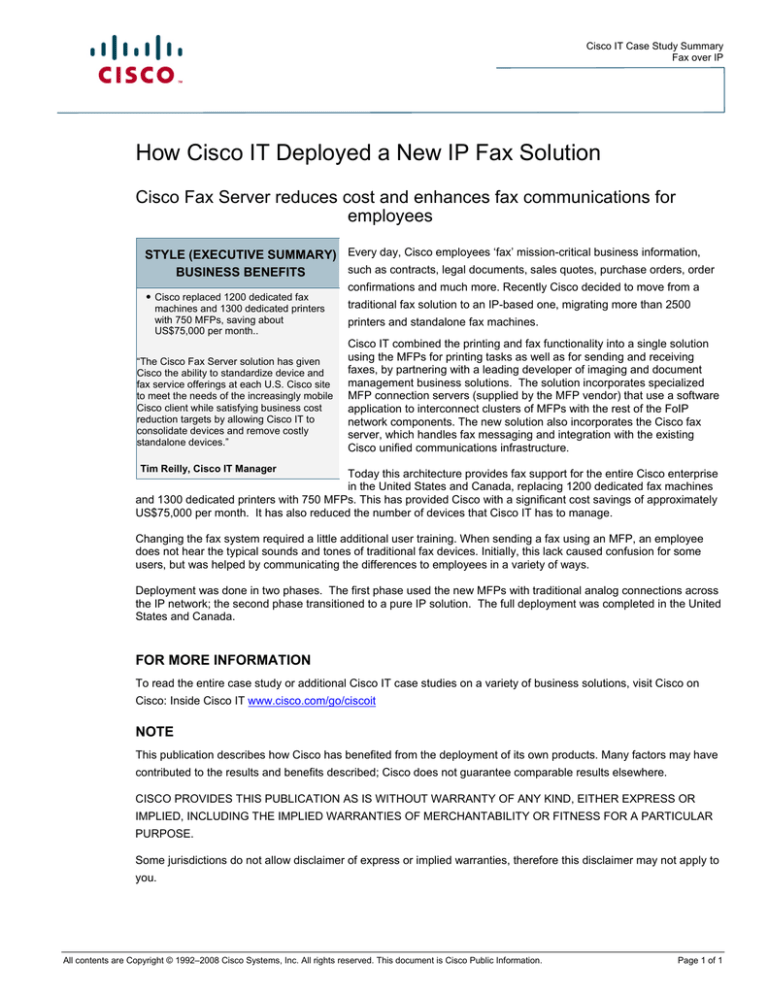
Cisco IT Case Study Summary
Fax over IP
How Cisco IT Deployed a New IP Fax Solution
Cisco Fax Server reduces cost and enhances fax communications for
employees
STYLE (EXECUTIVE SUMMARY) Every day, Cisco employees ‘fax’ mission-critical business information,
such as contracts, legal documents, sales quotes, purchase orders, order
BUSINESS BENEFITS
● Cisco replaced 1200 dedicated fax
machines and 1300 dedicated printers
with 750 MFPs, saving about
US$75,000 per month..
“The Cisco Fax Server solution has given
Cisco the ability to standardize device and
fax service offerings at each U.S. Cisco site
to meet the needs of the increasingly mobile
Cisco client while satisfying business cost
reduction targets by allowing Cisco IT to
consolidate devices and remove costly
standalone devices.”
confirmations and much more. Recently Cisco decided to move from a
traditional fax solution to an IP-based one, migrating more than 2500
printers and standalone fax machines.
Cisco IT combined the printing and fax functionality into a single solution
using the MFPs for printing tasks as well as for sending and receiving
faxes, by partnering with a leading developer of imaging and document
management business solutions. The solution incorporates specialized
MFP connection servers (supplied by the MFP vendor) that use a software
application to interconnect clusters of MFPs with the rest of the FoIP
network components. The new solution also incorporates the Cisco fax
server, which handles fax messaging and integration with the existing
Cisco unified communications infrastructure.
Tim Reilly, Cisco IT Manager
Today this architecture provides fax support for the entire Cisco enterprise
in the United States and Canada, replacing 1200 dedicated fax machines
and 1300 dedicated printers with 750 MFPs. This has provided Cisco with a significant cost savings of approximately
US$75,000 per month. It has also reduced the number of devices that Cisco IT has to manage.
Changing the fax system required a little additional user training. When sending a fax using an MFP, an employee
does not hear the typical sounds and tones of traditional fax devices. Initially, this lack caused confusion for some
users, but was helped by communicating the differences to employees in a variety of ways.
Deployment was done in two phases. The first phase used the new MFPs with traditional analog connections across
the IP network; the second phase transitioned to a pure IP solution. The full deployment was completed in the United
States and Canada.
FOR MORE INFORMATION
To read the entire case study or additional Cisco IT case studies on a variety of business solutions, visit Cisco on
Cisco: Inside Cisco IT www.cisco.com/go/ciscoit
NOTE
This publication describes how Cisco has benefited from the deployment of its own products. Many factors may have
contributed to the results and benefits described; Cisco does not guarantee comparable results elsewhere.
CISCO PROVIDES THIS PUBLICATION AS IS WITHOUT WARRANTY OF ANY KIND, EITHER EXPRESS OR
IMPLIED, INCLUDING THE IMPLIED WARRANTIES OF MERCHANTABILITY OR FITNESS FOR A PARTICULAR
PURPOSE.
Some jurisdictions do not allow disclaimer of express or implied warranties, therefore this disclaimer may not apply to
you.
All contents are Copyright © 1992–2008 Cisco Systems, Inc. All rights reserved. This document is Cisco Public Information.
Page 1 of 1
Cisco IT Case Study Summary
[Name]
All contents are Copyright © 1992–2008 Cisco Systems, Inc. All rights reserved. This document is Cisco Public Information.
Page 2 of 2


